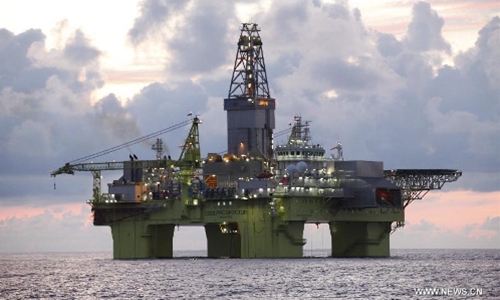CNOOC puts Liuhua cluster into production early in South China Sea
Source: Global Times Published: 2020/9/20 21:03:41

Photo taken on June 13, 2015 shows the Xingwang deep-sea semi-submersible drilling platform at Liwan3-2 gasfield in the South China Sea, south China. China's largest offshore oil and gas producer CNOOC Ltd. announced on July 3, 2015 that its Xingwang deep-sea semi-submersible drilling platform has started drilling at 1,300 meters underwater level in Liwan 3-2 gas field in the South China Sea. (Xinhua/Zhao Liang)
China's largest offshore oil producer China National Offshore Oil Corp (CNOOC) on Sunday announced that its Liuhua 16-2 oilfield cluster commenced production in the South China Sea ahead of schedule.
Liuhua 16-2, China's first domestic-support deepwater oil and gas project, is expected to achieve a maximum output of 4.2 million cubic meters of crude oil annually, equivalent to one year's gasoline consumption by more than 4 million cars.
The cluster is located in the eastern South China Sea, about 240 kilometers southeast of Hong Kong. The cluster includes Liuhua 16-2, Liuhua 20-2 and Liuhua 21-2 with an average depth of 410 meters, the deepest-water project in China's offshore oil sector.
The project is equipped with the FPSO (floating production storage and offloading) platform Haiyangshiyou119, which can process 21,000 cubic meters of crude oil and 540,000 cubic meters of natural gas per day, equivalent to the capacity of an onshore oil plant covering 300,000 square meters.
The central government has asked national oil companies to enhance oil exploration to raise production. Even with a low oil price scenario, CNOOC increased oil and gas output in the first half of 2020 by 6 percent and 16 percent year-on-year, respectively, showing its efforts to safeguard China's oil security.
Faced with China's foreign oil dependency ratio reaching 72.5 percent in 2019, CNOOC is further stepping up efforts to increase oil output. By 2025, its output in the eastern South China Sea is expected to reach 20 million tons, and the Liuhua16-2 project will play a key role in achieving the target.
Posted in: ECONOMY,BIZ FOCUS